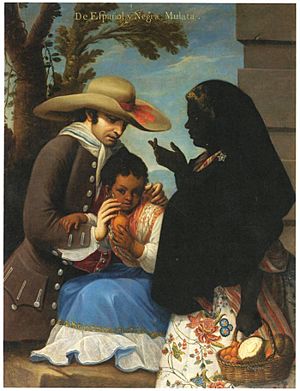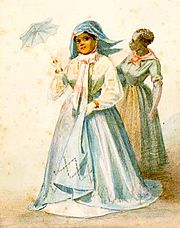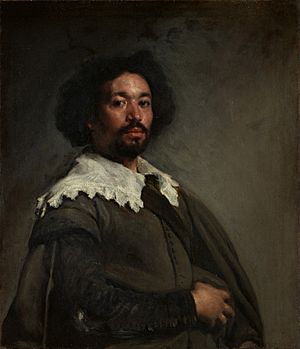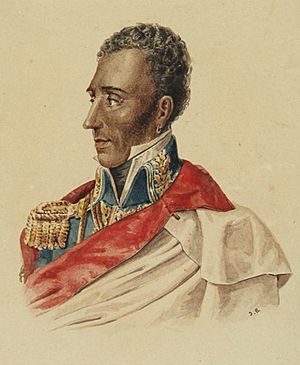Mulatto facts for kids
Mulatto is an old term used to describe people with both African and European family backgrounds. Today, this word is considered old-fashioned and can be offensive. A mulatta is the female form of the word.
Contents
Where the Word Comes From
The English word mulatto comes from the Spanish and Portuguese word mulato. This term was often used in the southeastern United States during the time of slavery.
Some people think the word comes from the Spanish word mula, which means mule. A mule is a mix of a horse and a donkey. This idea suggests the word was used to describe someone of mixed heritage.
Other experts believe it comes from the Arabic word muwallad. This word means "a person of mixed ancestry." It was used to describe people born and raised among Arabs but not of Arab blood. In some places, like old Spain (called al-Andalus), muwallad referred to people who were not Arab but adopted the Islamic religion and culture.
The word mulatto has been used in English writings since at least the 1500s. The Oxford English Dictionary once defined it as someone born from a European and a Black person. Over time, the term became seen as offensive.
People of Mixed Heritage in Africa
In countries like São Tomé and Príncipe and Cape Verde, many people are called mestiço. This term means mixed race. Most of these people are descendants of Portuguese settlers and Black Africans who were brought to the islands as slaves. In the past, mestiços often acted as interpreters because they could speak both Portuguese and African languages.
In Angola and Mozambique, mestiços are smaller groups but still important.
The terms mulatto and mestiço are not commonly used in South Africa. Instead, people of mixed ancestry often use the term "Coloured". This term recognizes their diverse family backgrounds.
South Africa's "Coloured" People
In South Africa, "Coloured" is a term for people with some African ancestry who were not considered "black" under the old Apartheid laws. Today, many people proudly identify as "Coloured." Other terms used include Bruinmense (brown people).
During Apartheid, the government tried to divide "Coloured" people into different groups. This was to control and classify people based on their race. Laws were even passed to stop mixed marriages.
"Coloured" people often have a mix of European, African, and sometimes Asian ancestry. This Asian heritage comes from immigrants from places like India, Indonesia, and China. This mixing of cultures and backgrounds was very common, especially in the Western Cape region.
In other parts of South Africa, "Coloured" people usually came from two main groups: various African tribes and European settlers. The meaning of "Coloured" has changed over time. For example, in an early census, Indians were sometimes counted as "Coloured."
The Griqua are another group of mixed heritage. They are descendants of Khoisan people and Dutch settlers called trekboers. Their leader, Adam Kok I, was a former slave who was given land. He created a safe place for runaway slaves and other people.
Mixed Heritage in Latin America and the Caribbean
Mulattoes in Old Spanish America

Africans were brought to Spanish America as slaves starting in the 1500s. Children born from Spanish fathers and African mothers were called Mulattoes. Under Spanish law, a child's status followed the mother's. So, if the mother was enslaved, her child was also enslaved, even if the father was Spanish.
Official records often used the term "Mulatto." Sometimes, lighter-skinned enslaved people were called mulato blanco (white mulatto). They might try to pass as free people. Darker-skinned mulattoes were sometimes called mulatos prietos.
Racial labels could be flexible. For example, a woman might be called a mulatta, but if she grew up in an Indigenous community and spoke their language, she might be seen as India (Indigenous) instead. In colonial Latin America, "mulatto" could also mean someone of mixed African and Native American ancestry, but the term zambo was more often used for that mix.
In the late 1700s, some mixed-race people tried to get "certificates of whiteness" (cédulas de gracias al sacar). This allowed them to improve their social standing and work in certain jobs. But many jobs, like being a lawyer or a doctor, were closed to them. A mulatta declared white could even marry a Spaniard.
Gallery
-
Casta painting of a Spaniard, a Negra and a Mulatto. José de Alcíbar, 18th century Mexico.
-
From a Mulatto and a Mestiza, a Torna atrás.
Mixed Heritage in Modern Times
Brazil
In Brazil, many people identify as pardo, which means they have mixed ancestry. This group includes mulattoes and people with European and Native American roots. Most Brazilians with mixed heritage have a blend of Native American, European, and African ancestry.
Even some Brazilians who identify as "White" have some mixed ancestry, according to genetic studies. Brazilians who identify as "Black" also often have a mix of African, European, and Native American genes. This shows that how people see themselves can be different from their full genetic background.
Haiti
Mulattoes make up a small but important part of Haiti's population. In Haitian history, these mixed-race people were known as free people of color. Before the Haitian Revolution, they often gained education and property. Some white fathers even sent their mixed-race sons to France for schooling.
These free people of color had some social standing and political power. They were important during the Revolution and have kept their influential position in Haiti's society. Many leaders in Haiti's history have been people of color.
The Haitian Revolution involved struggles between mulattoes and Black Haitians. One famous conflict was the War of Knives between André Rigaud (mulatto) and Toussaint Louverture (Black). Toussaint eventually won.
Later, Haiti was divided into a Black-controlled north and a mulatto-ruled south. Jean-Pierre Boyer, a mulatto, unified Haiti but often excluded Black people from power. In 1847, a Black military officer named Faustin Soulouque became president. He worked to gain the support of Black Haitians, which led to conflicts with the mulatto elite.
Puerto Rico
In Puerto Rico during colonial times, laws allowed people with African ancestry to be considered legally white. This was possible if they could show that at least one person in each of their last four generations was legally white. This was different from the "one-drop rule" that later became common in the United States.
Mixed Heritage in the United States
Colonial and Early American Times

During slavery in the United States, many children were born with mixed racial backgrounds. This often happened when white men, like plantation owners, had children with enslaved women. Starting in Virginia in 1662, laws stated that a child's status followed the mother's. So, children born to enslaved mothers were also enslaved, no matter who their father was.
However, children born to white mothers were free, even if they were mixed-race. Many free people of color in the southern United States came from unions between white women and African or African-American men. In early colonial times, working-class people of different races lived and worked closely. This led to many free families of African descent.
Historically, in the American South, the term "mulatto" was sometimes used for people with mixed Native American and African American ancestry. For example, a 1705 Virginia law said that a child of a Native American and a Black person would be considered a mulatto.
However, many Native American tribes had their own ways of including people. Children born to Native American mothers were usually raised in her family and tribal culture. These mixed-race individuals were often considered full members of their tribes, regardless of their European or African ancestry.
If mixed-race children were born to enslaved women, they were usually classified as enslaved. This was because Native American slavery was abolished, but African slavery continued.
Influence of Mixed-Race Individuals
Some mixed-race people in the South became wealthy and even owned slaves themselves. Sometimes, they held family members in slavery because it was difficult to free slaves under the laws. By the time of the Civil War, many free people of color supported the Confederacy. For example, William Ellison owned 60 slaves.
Other mixed-race people became abolitionists and supported the Union. Frederick Douglass, who escaped slavery, became a famous abolitionist leader in the North.
People like Mary Ellen Pleasant and Thomy Lafon used their wealth to support the abolitionist cause. Francis E. Dumas, a free person of color in New Orleans, freed his slaves and organized them into a military company to fight for the Union.
Today
The term "Mulatto" was used as an official racial category in the United States Census until 1930. After that, some states passed "one-drop rule" laws, which meant anyone with any African ancestry was classified as "black."
In the 2000 United States Census, about 6,171 Americans identified as having mulatto ancestry. Since then, people can choose to identify with more than one ethnic background on the census.
See also
 In Spanish: Mulato para niños
In Spanish: Mulato para niños












